Trikala,Thessaly 作者: 来源: 发布时间:2021-07-12
I.Population and Area
Location within the region
Coordinates: 39°33′N 21°46′E
Country Greece
Administrative region Thessaly
Regional unit Trikala
Area
• Municipality 607.59 km2 (234.59 sq mi)
• Municipal unit 69.2 km2 (26.7 sq mi)
Elevation 115 m (377 ft)
Population (2011)
• Municipality 81,355
• Municipality density 130/km2 (350/sq mi)
• Municipal unit 62,154
• Municipal unit density 900/km2 (2,300/sq mi)
Time zone UTC+2 (EET)
• Summer (DST) UTC+3 (EEST)
Postal code 421 00
Area code(s) 24310
Vehicle registration ΤΚ
Trikala (Greek: Τρίκαλα) is a city in northwestern Thessaly, Greece, and the capital of the Trikala regional unit. The city straddles the Lithaios river, which is a tributary of Pineios. According to the Greek National Statistical Service, Trikala is populated by 81,355 inhabitants (2011), while in total the Trikala regional unit is populated by 131,085 inhabitants (2011).
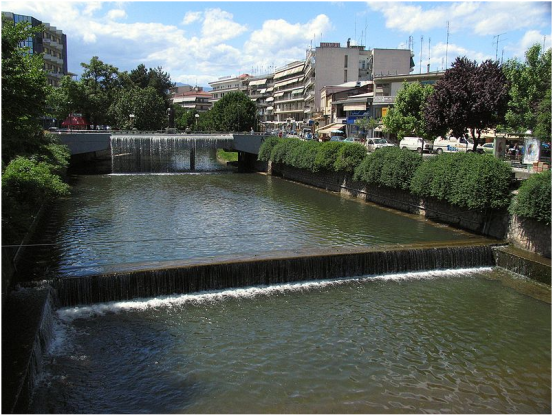
II.Natural Geography (environment and resources)
Transport
The city is served by a railway station. There are daily basis train connection to Athens. The city also served by E65 highway and Ktel busses.
Trikala railway station
Trikala railway station (Greek: Σιδηροδρομικός σταθμός Τρικάλων) is a railway station in Trikala, Thessaly, Greece. The station is served by regional trains between Palaiofarsalos and Kalambaka.
History
The station was opened on 16 June 1886, by the Thessalian Railways Company. Trikala was one of main line stations (as shown by the impressive original station building) along with Farsala and Kalambaka.
Freight traffic declined sharply when the state-imposed monopoly of OSE for the transport of agricultural products and fertilisers ended in the early 1990s. Many small stations of the network with little passenger traffic were closed down, especially on the mainline section and between Karditsa and Kalampaka. In 2001 the section between Kalampaka and Palaiofarsalos was converted from 600 mm gauge to standard gauge and physically connected at Palaiofarsalos with the mainline from Athens to Thessaloniki. Since to upgrade, however, travel times improved and the unification of rail gauge allowed direct services, even InterCity services, to link Volos and Kalambaka with Athens and Thessaloniki.
Today the small Trikala Museum Showroom, located in a square opposite the Station showcases a small steam engine and two auxiliary wagons of the old Thessaly Network
Facilities
The station has a footbridge from platform 1 to platform 2, via stairs or lift.
Services
Today, the station is served by direct lines to the rest of Greece, via Palaiofarsalos, served both by intercity trains to Athens, Palaiofarsalos Larissa and Thessaloniki and Proastiakos to Athens. Previously Thessaly Railways operated a narrow gauge service to Volos.
In August 2009 TrainOSE S.A. proceeded to a drastic cutback of passenger services on Thessaly lines. As of Spring 2020 There are ten (five in each direction) Regional services on Palaiofarsalos-Kalambaka Line. In addition, there is one Regional train to Athens from Kalambaka and back (884/885).
The old station building and the current platforms (March 2009)
Website http://www.ose.gr/en/
III.Economy
GDP – city:
Between USD 10,000 and USD 15,000
Reference: https://uil.unesco.org/city/trikala
Property Prices in Trikala, Greece
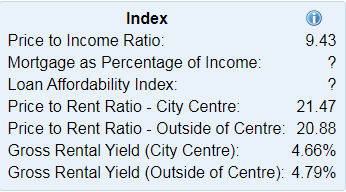
Reference: https://www.numbeo.com/property-investment/in/Trikala-Greece
IV.Industrial Characterisitics
The Most Popular Driverless Bus Pilot
One of the first and the most popular smart city project that came to Trikala was a driverless bus pilot funded by the European Commission. The pilot operated for six months and gathered widespread coverage locally and internationally. This project made Trikala the first city to implement a self-driving bus.
After the successful completion of the project, Dimitris Papastergiou, the mayor of Trikala launched two new electric vehicles for the public on 19 September 2018. The project is the result of a partnership with the innovative transit company Elviten. This project is not just confined to Trikala but rather extended to five more cities in Greece.
The electric vehicles are equipped with an intelligent recording and tracking device that registers the location, speed, delay, and the vehicles way of moving across the city. In addition to the new electric vehicles, Gorgolis SA has donated a light-duty electric vehicle to the city which will be deployed for the cleaning of the city. The new vehicles came to roads for the maiden rides from the 1st of October.
The city of Trikala has been rolling out several innovative projects for sustainable mobility and yet focuses on exploring new ways of making transportation more sustainable in the urban environment.
Trikala As The First Greece City To Welcome 5G Technology
Trikala has been officially announced by Greece as the first city to welcome a 5G wireless technology. In March 2018, Trikala, e-Trikala and Greece’s General Secretariat of Telecommunications and Post signed an agreement for the construction of a free 5G pilot network to test the new technology in the city. The city of Trikala was seen as the most suitable candidate for the project as it had already piloted new technologies like self-driving bus before other Greek cities.
As a part of the new project, the city will test 5G-enabled smart parking, smart lighting, data collection and analysis, public wireless internet access and other conventional commercial solutions.
Other Smart City Initiatives In Trikala
There are several other projects to name that have achieved impressive results. One of them is sensor-equipped streetlights that helped in curbing electricity usage by 70%. The streetlights have been integrated with a wireless control system which detects malfunctions in the early stages, adjusts lights intuitively and schedules inspections when needed. So these streetlights are a comprehensive solution to achieving maximum energy savings while enhancing visibility and ultimate safety for pedestrians, cyclists, and drivers.
Another impressive initiative is e-Kep that offers a special ATM-like machine to the citizens to request and print out any municipality related documents like clearance certificates, civil register certificates etc. The machine allows for 24/7 easy and quick access via a Resident Card making way for dynamic e-services for the citizens.
Going ahead, the city is now showing its desire to join the EU Activage programme which tests smart houses, especially for elderly healthcare. The aim is to have smart houses that can monitor elderly resident’s health by keeping a track on their movements and food consumption.
Trikala is also aiming at developing a farm project that deploys technology to grow ancient medicinal plants for the pharmaceutical industry. The main idea towards introducing this project is to open doors of new employment opportunities, particularly for youngsters and therefore conquer the biggest problem of Trikala and Greece – emigration of highly-skilled people to other countries. Greece has already witnessed about 420,000 citizens (mostly young generation) moving to other countries due to financial crisis since 2008. The youth unemployment rate in 2013 reached 50% which has currently moved down to 44% – yet the highest in Europe.
Hopefully, with Trikala making commendable strides in the form smart city initiatives, it is most likely that the city will not just come over the financial crisis and the brain drain, but also offer citizens an improved standard of living.
Reference: https://www.smartcity.press/trikala-smart-initiatives/
V.Attractions
-- The archaeological site of Asklepieion of Trikke, the most significant and most ancient of Greece, according to Strabo.
-- The Byzantine Castle, built by Justinian onto the acropolis of ancient Trikke in the 6th century AD. Later it was rebuilt by the Ottomans, who in the 17th century placed a huge clock tower, which was accompanied by a bell weighing 650 kg (1,433 lb). In 1936, another clock tower was placed and today remains the trademark of the city, while offers a panoramic view to the city.
-- The Osman Shah Mosque (16th century), building designed by Mimar Sinan. Behind the mosque stands the mausoleum of Osman Shah, nephew of Sultan Suleyman the Magnificent.
-- The Old City of Trikala, which consists of the districts Varousi and Manavika. Varousi was the Christian district of Trikala during the Ottoman rule and is located at the foot of the fortress. Until 1930, this part of the city was considered as the noble district of Trikala and is now preserved in its entirety, with a large number of old buildings, built between 17th and 19th century, preserved until today. In this part are located the oldest churches of the city. Following the district Varousi up to the central square is the part of the city called Manavika, a neighborhood of the old city with a uniform architecture. Here are located some of the best restaurants, coffee shops, and bars in town.
-- The hill of Prophitis Ilias, a park with a nice view of the city and within walking distance from the city center. On this hill is situated the church of the Prophet Elijah and the zoo.
-- Lithaios river and the Central Bridge, built in 1886, which connects the central square with the Asclepius pedestrian zone.
-- The Mill of Matsopoulos, which was constructed in 1884 and today is a historical-industrial building and cultural center. During the Christmas period, the stone-built Matsopoulos Mill transforms into the “Mill of Elves”, a famous Christmas park
-- The Trikala Train Station, built in 1886, the courthouse and many more historical and neoclassical buildings.
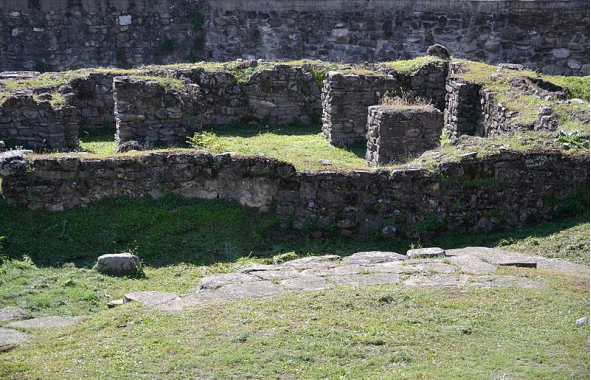
Ruins of the Roman baths. Underneath lie the ruins of the ancient Asclepeion.
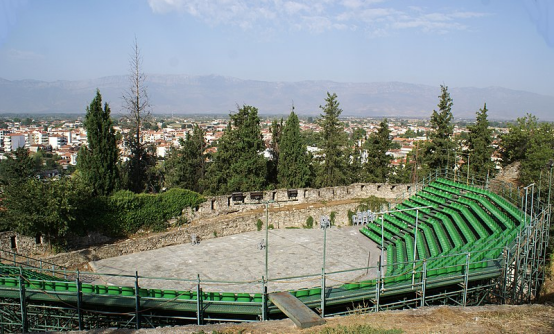
Open theatre in the castle
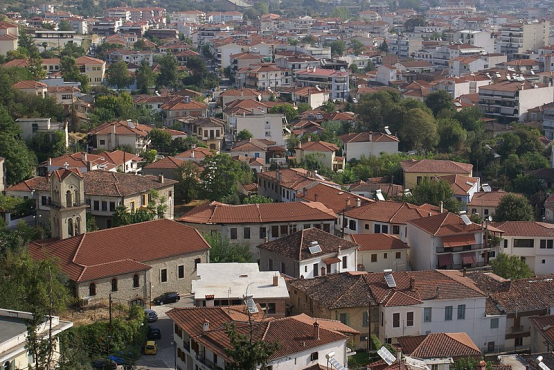
View of the old town of Varousi from the castle.
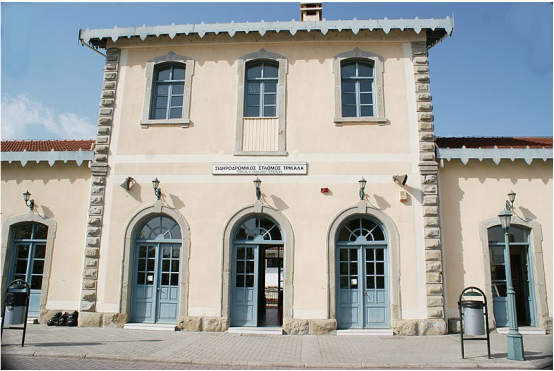
Railway station building.
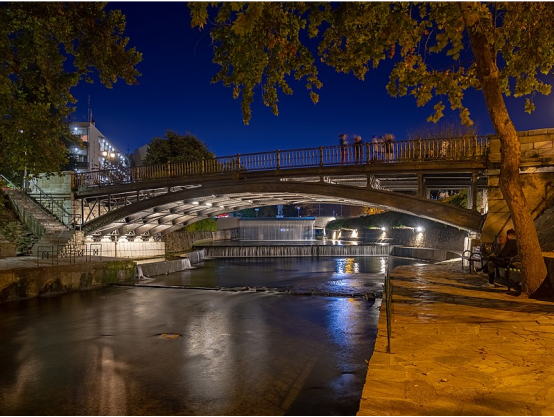
Central bridge
VI.History
Antiquity
The region of Trikala has been inhabited since prehistoric times. The first indications of permanent settlement have been uncovered in the cave of Theopetra, and date back to approx. 49,000 BC. Neolithic settlements dating back to 6,000 BC have been uncovered in Megalo Kefalovriso and other locations.
The city of Trikala is built on the ancient city of Trikka or Trikke, which was founded around the 3rd millennium BC and took its name from the nymph Trikke, daughter of Peneus, or according to others, daughter of the river god Asopus. The ancient city was built at a defensive location in between the local hill and the river Lithaios. The city became an important center in antiquity and it was considered to be the birthplace and main residence of the healing god Asclepius. The city exhibited one of the most important and ancient of Asclepius' healing temples, called asclepieia. The city is mentioned in Homer's Iliad as having participated in the Trojan War with thirty ships under Asclepius' sons Machaon and Podalirius. In the Mycenean period, the city was the capital of a kingdom, and later it constituted the main center of the Thessalian region of Estaiotis, which occupied roughly the territory of the modern Trikala Prefecture.
In historical times, the city of Trikke and the surrounding area experienced prosperity. It fell to the Achaemenid Persians in 480 BC, while ten years later it joined the Thessalian monetary union. In 352 BC it was united with the Macedonia of Philip II. The city became a location of hard battles between Macedonia and Rome. While Philip V of Macedon and his son Perseus tried to keep the city, after 168 BC it fell to the Roman Republic.
Middle Ages
While the area was considered to be firmly under the rule of the Byzantine Empire, it was invaded nevertheless by a succession of raiders and nomadic tribes. Some of these tribes that raided the area include: Goths (396), Huns (447), Slavs (577), Bulgarians (986-1000), Normans (1082/3), Catalans (1309–1311).
The current name of Trikala first appears in the 11th-century Strategikon of Kekaumenos, where "Trikalitan Vlachs" are mentioned, and then in the early 12th-century Alexiad of Anna Komnene. Later in the century, the Arab traveller and geographer al-Idrisi recorded the town as "an important agrarian center with abundant vineyards and gardens" (T.E. Gregory).
After the dissolution of the Byzantine state by the Fourth Crusade in 1204, Trikala does not appear to have fallen into Frankish hands, but became part of the Despotate of Epirus. Epirote rule lasted until 1259, when the town was taken without resistance by the Empire of Nicaea (after 1261 the renewed Byzantine Empire) following the Battle of Pelagonia. In the early 14th century the town was the capital of a semi-independent domain under the sebastokrator Stephen Gabrielopoulos, which extended across much of western Thessaly and Macedonia. After his death in 1332/3 the city, along with most of Gabrielopoulos' lands, was seized by the Epirote ruler John II Orsini, but he was in turn expelled and the area incorporated into the Byzantine Empire by Andronikos III Palaiologos.
In 1348, Thessaly was conquered by Stephen Dushan and incorporated into the newly established Serbian Empire. The Serbian general Preljub was made the region's governor, and established himself at Trikala. In 1359, Dushan's half-brother Symeon Uroš established his court at Trikala, and in 1366/7 he founded the Meteora monasteries nearby. Symeon was succeeded by his son John Uroš, and he in turn by the local magnates Alexios Angelos Philanthropenos and Manuel Angelos Philanthropenos, who ruled until the Ottoman conquest of Thessaly in 1393/4.
Ottoman period
Under Ottoman rule, the city was called Tırhala. Its fortunes in the early period of Ottoman rule are unclear: it is reported as being part of a large sanjak under Ahmed, the son of Evrenos Bey, but in the early 15th century it formed part of the domain of Turahan Bey, who brought in Muslim settlers and granted privileges to the local Greek population. Turahan and his son and successor, Ömer Bey, erected many buildings in the city, helping it, in the words of the historian Alexandra Yerolimpos, to "[acquire] the appearance of a typical Ottoman town, with mosques, medreses, a hammam, imaret, khan and karwansaray extending beyond the citadel and the Varoussi (Varosh) quarter which remained Christian".
As the administrative center of the local province (the Sanjak of Trikala), the city attracted Muslim immigrants and had large Muslim and Jewish communities: in the 1454/5 census, the city had 2,453 inhabitants (251 Muslim families and 9 widows, and 212 Christian families and 73 widows); in 1506, the city numbered 3,100 inhabitants, with 260 Muslim, 310 Christian and 19 Jewish families; in 1520/38, the number had risen to 301 Muslim, 343 Christian, and 181 Jewish families. The city also became an important intellectual center during these years (1543-1854) with the Trikke School (and later Greek School), where famous intellectuals of the time, such as Dionysius the Philosopher, taught.
The 17th-century Ottoman traveller Evliya Çelebi reports that the city had 2,300 houses divided into sixteen Muslim and eight Christian quarters (mahalla); eight mosques, of which only the city's main mosque, the Osman Shah Mosque built by Mimar Sinan, survives today; four hammams; six tekkes; and the probably exaggerated number of 1,000 shops, although Evliya curiously does not mention the city's impressive bezesten (covered market) which was demolished in the early 20th century. The city was largely burned down in a great fire in 1749, a destruction repeated by Albanian irregulars following an abortive uprising by the local Christian population during the Orlov Revolt. Despite the destruction, its population seems to have remained the same, ca. 25,000, until the outbreak of the Greek Revolution in 1821. By 1840, it reportedly had only 10,000 inhabitants, with the last Ottoman census in 1877/8 listing 25,000 inhabitants for the entire sanjak of Trikala.
Modern period
On 23 August 1881 with the Treaty of Constantinople between the Ottoman Empire and the Kingdom of Greece, the city passed in Greek sovereignty, along with the rest of Thessaly. It became occupied again by Ottoman forces briefly during the Greco-Turkish War of 1897. In the years that followed, Trikala played a fundamental role in the rural workers' mobilizations, in the early 20th century, against the Thessalian landlords (Greek: Τσιφλικάδες). Trikala eventually became the city that the first Agricultural Cooperative of Greece was founded, in 1906.
The town lost much of its Ottoman and medieval buildings in the early 20th century, particularly after it was rebuilt to a modern urban plan in the 1930s.
VII.Other information
I would like to welcome you to Trikala, the birthplace of Asclepius, the first ancient doctor.
In Trikala, which is one of the oldest in Europe with a long history that goes back in 3,000 BC, we believe that Greek hospitality and friendliness synthesize your passports to enter our “Open” city.
Trikala is a city that combines innovation and culture, where the Municipality respects the local history, while it implements many smart solutions for its residents and visitors. Moreover, Trikala is friendly and offers special local flavors and spirits of high quality (i.e., feta cheese and pies, wine and tsipouro accordingly), while it makes citizens and visitors smile, explore the city with bicycles and boats in Litheos river or walk in its open spaces and museums.
Let’s walk together in Trikala, following the highways of the Internet.
Reference: https://trikalacity.gr//en/#participate
Infrastructure
Trikala is home to the General Hospital of the Trikala Prefecture. The Physical Education and Sport Science department of the University of Thessaly is also located in Trikala, and was founded in 1994, with the first students being admitted in the academic year 1994-1995; it was originally housed in the Matsopoulos Park facility, but moved to the new Karyes campus in July 1999. Trikala has over 20 schools of secondary education, and a modern night technical school also functions in the town.
Trikala has the distinction of being the first smart city in Greece, integrating new technologies into the daily life of the municipality and providing government services to citizens by means of e-governance. Furthermore, it is in the process of becoming Greece's first 5G-ready city.
E-Trikala: The First Greek Digital City
The Digital City ICT applications aim to improve everyday life by simplifying public transactions, reducing telecommunication costs and by delivering new services related to the local way of life
VIII.Contact information
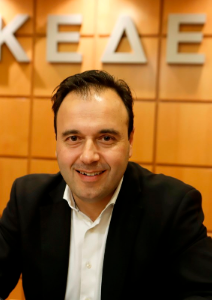
• Mayor Dimitris Papastergiou (New Democracy)
Tel.: 2431351200
Email: mayor@trikalacity.gr
Mayor Mr. Dimitris Papastergiou was born in Trikala in 1973. He studied Electrical and Computer Engineering and he loves electronics and software programming. His belief regarding the involvement with the public scene is that “it concerns is a one-way direction, if we want a change. That’s why I am participating in local community issues since the age of 29”. Furthermore, he has been a planner and developer of energy construction projects. He has been the Mayor of the Municipality of Trikala since 2014, leading the political party “Trikala Restart Now”. He is also a member of the commission of the Greek municipal Union (KEDE) and president of the corresponding committee for “Development, Innovation and Entrepreneurship”. His goal is to develop real smart and sustainable cities in Greece. He uses bicycle for his mobility in the city, as a habit and a deeper insight.
Address: Asklipiou 18, P.C.: TEL: 42131 2431351100
Email: info@trikalacity.gr
https://trikalacity.gr/en/
Facebook: Δήμος Τρικκαίων @DimosTrikkaionofficial
Twitter: Δήμος Τρικκαίων @dtrikkaion
Youtube: https://www.youtube.com/user/DimosTrikkaion Δήμος Τρικκαίων
Instagram: https://www.instagram.com/accounts/login/?next=/dimostrikkaion_official/
